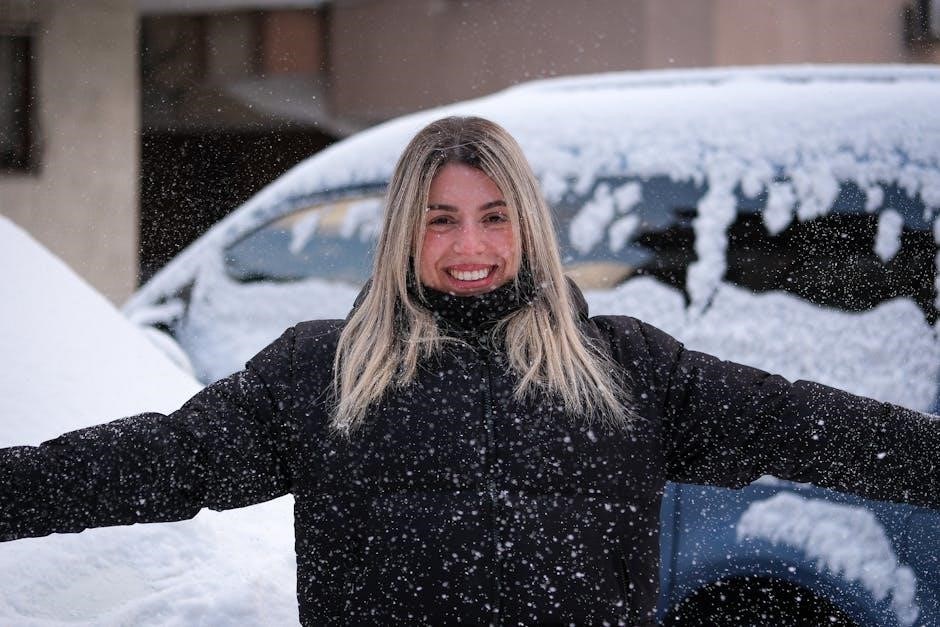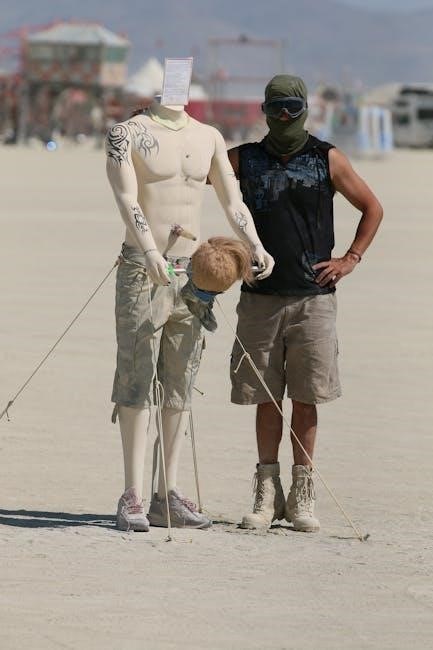EasyHeat Freeze Free Instructions: A Comprehensive Guide
EasyHeat Freeze Free systems offer reliable pipe freeze protection.
This guide provides comprehensive instructions for safe and effective installation.
Learn how to protect your pipes with EasyHeat’s self-regulating technology and prevent costly damage from freezing temperatures with the proper installation.
EasyHeat Freeze Free systems are designed to provide reliable and efficient freeze protection for residential and commercial piping. These systems utilize self-regulating heating cables that automatically adjust their heat output based on the surrounding temperature‚ ensuring optimal energy consumption and preventing overheating. The cut-to-length technology offers flexibility for various pipe lengths and configurations‚ making it ideal for complex installations.
EasyHeat Freeze Free systems are easy to buy‚ easy to install‚ and include all the materials needed for a safe and proper installation. They are suitable for use on metal or plastic domestic water pipes‚ including PVC‚ PEX‚ and polybutylene. These systems protect water supply lines in manufactured homes‚ cottages‚ barns‚ and outbuildings susceptible to freezing temperatures.
By preventing pipe freeze-ups‚ EasyHeat Freeze Free systems help avoid costly repairs and water damage. These systems are engineered for long-term performance‚ offering years of trouble-free service with proper installation and maintenance. They provide peace of mind by ensuring a consistent water supply even in the coldest conditions.
Understanding Self-Regulating Heating Cables
EasyHeat Freeze Free cables utilize self-regulating technology‚ a key feature that distinguishes them from conventional heating cables. Self-regulating cables contain a conductive polymer core that adjusts its heat output in response to temperature changes. This core is located between two bus wires‚ and as the temperature drops‚ more electrical paths form within the polymer‚ increasing the heat generated. Conversely‚ as the temperature rises‚ fewer electrical paths exist‚ reducing the heat output.
This self-regulating property ensures energy efficiency‚ as the cable only produces the heat necessary to prevent freezing. It also prevents overheating‚ even when the cable overlaps itself‚ making installation safer and more forgiving. Unlike constant wattage cables‚ self-regulating cables do not require a thermostat in many applications‚ further simplifying the system.
The ability of self-regulating cables to automatically adjust their heat output makes them ideal for various environments and pipe materials. They are suitable for both metal and plastic pipes‚ providing consistent freeze protection without the risk of damage due to excessive heat. This technology enhances the reliability and longevity of the EasyHeat Freeze Free system‚ offering dependable performance in diverse conditions.
Applications of EasyHeat Freeze Free Cables
EasyHeat Freeze Free cables are versatile and suitable for a wide range of applications where pipe freeze protection is crucial. They are commonly used in residential settings to protect water supply pipes‚ drain lines‚ and sprinkler systems from freezing during cold weather. These cables are particularly beneficial for pipes located in unheated areas such as crawl spaces‚ basements‚ and exterior walls.
In agricultural settings‚ EasyHeat Freeze Free cables safeguard water lines for livestock‚ irrigation systems‚ and greenhouses‚ ensuring a continuous water supply even in freezing conditions. Commercial applications include protecting pipes in restaurants‚ hotels‚ and office buildings‚ preventing costly damage and disruptions caused by frozen pipes. The cables are also ideal for use in remote locations like cabins‚ barns‚ and outbuildings that are not regularly heated.
Moreover‚ EasyHeat Freeze Free cables can be used in specialized applications such as protecting pipes in recreational vehicles (RVs)‚ mobile homes‚ and construction sites. Their flexibility and cut-to-length design make them adaptable to various pipe configurations and lengths‚ providing customized freeze protection wherever it is needed. With their ability to prevent pipe bursts and water damage‚ EasyHeat Freeze Free cables offer a reliable solution for maintaining water flow and preventing costly repairs.
Materials Required for Installation
Before commencing the installation of your EasyHeat Freeze Free cable‚ gathering the necessary materials is essential for a smooth and efficient process. First and foremost‚ you will need the EasyHeat Freeze Free self-regulating heating cable itself‚ ensuring it is the appropriate length for the pipe you intend to protect. A fused plug kit is crucial for establishing a safe electrical connection‚ providing overcurrent protection for the cable.
In addition to the cable and plug kit‚ high-quality electrical tape is needed to secure the cable to the pipe and protect connections from moisture. For optimal performance‚ pipe insulation is a must. Foam or fiberglass insulation helps to retain heat and improve the cable’s efficiency. You’ll also need a utility knife or scissors for cutting the insulation and cable ties or aluminum foil tape to secure the insulation in place.
Depending on your specific installation needs‚ you may also require a freeze protection controller to automatically regulate the cable’s operation based on temperature. Lastly‚ ensure you have appropriate safety gear such as gloves and eye protection to prevent injury during the installation process. Gathering all these materials beforehand will streamline your EasyHeat Freeze Free cable installation‚ ensuring a reliable and effective freeze protection system for your pipes.
Step-by-Step Installation Guide
Follow this comprehensive‚ step-by-step guide for installing your EasyHeat Freeze Free system. Prior to installation‚ ensure the pipe surface is clean and dry. Begin by measuring the length of pipe requiring protection‚ adding extra length for valve tracing if needed. Then‚ carefully attach the EasyHeat Freeze Free cable to the underside of the pipe using electrical tape every foot. For plastic pipes‚ use aluminum foil tape before securing the heating cable.
Next‚ assemble the fused plug kit according to the manufacturer’s instructions‚ ensuring a secure and waterproof connection. Wrap the pipe and cable with high-quality pipe insulation‚ overlapping the seams to prevent heat loss. Secure the insulation with cable ties or additional foil tape. If using a freeze protection controller‚ install it in a convenient location and connect the cable according to the controller’s instructions.
Finally‚ plug the fused plug into a properly grounded electrical outlet. Regularly inspect the installation for any signs of damage or wear. By following these steps carefully‚ you can ensure the EasyHeat Freeze Free system provides reliable and effective freeze protection for your pipes‚ preventing costly damage during cold weather. Always exercise caution and adhere to safety guidelines during the installation process for optimal results and peace of mind.

Cutting the Cable to Length
The EasyHeat Freeze Free system’s cut-to-length feature offers unparalleled flexibility‚ allowing customization for diverse pipe configurations. Before cutting‚ meticulously measure the precise length needed for each pipe section requiring freeze protection‚ accounting for valves‚ faucets‚ and any complex geometries; Remember that once cut‚ the cable cannot be rejoined‚ so accurate measurement is crucial to avoid waste or insufficient coverage.
Use a sharp utility knife or cable cutters to ensure a clean‚ perpendicular cut. Avoid crushing or deforming the cable during the cutting process‚ as this could compromise its self-regulating properties and overall performance. After cutting‚ carefully inspect the cut end for any exposed wires or damage to the insulation. If any damage is detected‚ trim back slightly to obtain a clean end.
When cutting‚ always err on the side of caution and leave a little extra length. This provides flexibility during installation and allows for adjustments if needed. The excess cable can be looped along the pipe or carefully trimmed after the installation is complete. Properly cutting the cable to length is a critical step in ensuring the EasyHeat Freeze Free system provides efficient and reliable freeze protection for your specific application. Always prioritize safety and precision during this process.
Assembling the Cable and Fused Plug Kit
Proper assembly of the EasyHeat Freeze Free cable and fused plug kit is paramount for a safe and effective freeze protection system. Begin by carefully reviewing the instructions included with the kit‚ identifying all components. Ensure the cable end is cleanly cut‚ as described previously‚ without any frayed wires or damaged insulation. Prepare the cable end by carefully stripping back the outer jacket to expose the internal conductors‚ following the kit’s specific measurements.
Next‚ attach the appropriate connectors from the kit to the exposed conductors‚ ensuring a secure and reliable electrical connection. Crimp the connectors firmly using a proper crimping tool to prevent loose connections‚ which could lead to overheating or system failure. Slide the fused plug housing over the connectors‚ ensuring all wires are properly seated within the housing.
Secure the housing according to the kit’s instructions‚ typically involving screws or a snap-fit mechanism. Double-check that all connections are tight and secure before inserting the fuse into the designated slot. The fuse is a critical safety component‚ protecting the system from overloads and short circuits. Ensure the fuse rating matches the specifications outlined in the EasyHeat Freeze Free manual. A correctly assembled cable and fused plug kit guarantees a safe and reliable connection to your power source‚ enabling optimal freeze protection.
Attaching the Cable to the Pipe
Securely attaching the EasyHeat Freeze Free cable to the pipe is crucial for effective heat transfer and freeze protection. Before starting‚ ensure the pipe surface is clean‚ dry‚ and free of any sharp edges or protrusions that could damage the cable. Using the recommended heat-resistant tape‚ such as electrical tape or specifically designed pipe tracing tape‚ begin securing the cable to the pipe.
Follow a consistent pattern‚ typically a spiral wrap‚ ensuring the cable makes direct contact with the pipe along its entire length. Avoid overlapping the cable‚ as this can lead to uneven heat distribution. Pay particular attention to areas prone to freezing‚ such as valves‚ fittings‚ and pipe entry points. Secure the cable more tightly in these areas to provide extra protection. For plastic pipes‚ use only tape that is approved for use with plastics to prevent damage.
The EasyHeat Freeze Free instructions might suggest running the cable along the bottom of the pipe‚ as heat rises‚ optimizing the warming effect. If the pipe is against a wall‚ position the cable on the exposed side. Ensure the cable is firmly attached‚ but avoid stretching or kinking it‚ which could compromise its performance. Proper attachment guarantees efficient heat transfer from the cable to the pipe‚ preventing freezing and ensuring reliable operation of the EasyHeat Freeze Free system.
Insulating the Pipe
After attaching the EasyHeat Freeze Free cable‚ insulating the pipe is essential to maximize energy efficiency and prevent heat loss. Insulation traps the heat generated by the cable‚ directing it towards the pipe and minimizing heat dissipation into the surrounding environment. This reduces the cable’s energy consumption and ensures consistent freeze protection‚ especially during extremely cold temperatures.
Select insulation materials suitable for both the pipe material and the environmental conditions. Foam pipe insulation‚ fiberglass wrap‚ or rubber insulation are commonly used. Ensure the insulation is non-flammable and specifically designed for pipe insulation applications. Apply the insulation tightly around the pipe‚ covering the heating cable completely. Secure the insulation with tape or bands to maintain a snug fit and prevent gaps where heat could escape.
For optimal performance‚ use insulation with a thickness of at least 1/2 inch. In colder climates‚ consider using thicker insulation for enhanced protection. Pay close attention to insulating valves‚ fittings‚ and any exposed sections of the pipe. Properly installed insulation significantly improves the effectiveness of the EasyHeat Freeze Free system‚ reducing the risk of frozen pipes and lowering energy costs. Following the EasyHeat Freeze Free instructions regarding insulation is vital for a reliable and energy-efficient system.
Electrical Connection and Safety

Proper electrical connection is paramount for the safe and effective operation of your EasyHeat Freeze Free system. Always adhere to all local electrical codes and regulations. Use a Ground Fault Circuit Interrupter (GFCI) protected outlet for the electrical connection to minimize the risk of electrical shock. The National Electrical Code requires that a heating cable system electrical outlet located on the underside of a mobile home MUST be WITHIN 2 feet of the cold water inlet.
Before plugging in the cable‚ inspect it for any signs of damage‚ such as cuts or abrasions. Do not use the cable if it appears damaged. Ensure the fused plug kit is correctly assembled and securely attached to the heating cable. Never submerge the electrical connections in water. Keep the area around the outlet and connections dry.
Only connect the Freeze Free system to an electrical outlet so located. Do not overload the circuit with other appliances. Disconnect the cable from the power source before performing any maintenance or repairs. If you are unsure about any aspect of the electrical connection‚ consult a qualified electrician. Following these safety precautions will ensure the reliable and safe operation of your EasyHeat Freeze Free system. Proper adherence to electrical safety guidelines is vital for preventing accidents and ensuring long-term performance.

Using a Freeze Protection Controller
A freeze protection controller enhances the efficiency and convenience of your EasyHeat Freeze Free system. This device automatically regulates the heating cable’s operation‚ minimizing energy consumption and providing optimal freeze protection. Installation is easy with no special wiring required.
The controller typically features a temperature sensor that monitors the pipe’s surface temperature. When the temperature drops below a set threshold‚ the controller activates the heating cable. Once the pipe warms up‚ the controller deactivates the cable‚ preventing overheating and saving energy. This pre-set thermostat automatically reduces the risk of frozen pipes and eliminates the need to unplug pipe heating cables each spring.
Some controllers offer adjustable temperature settings‚ allowing you to customize the protection based on your specific needs and climate. By using a freeze protection controller‚ you can ensure that your pipes are protected only when necessary‚ reducing energy waste and lowering your electricity bill. Consider installing a controller to optimize the performance and cost-effectiveness of your EasyHeat Freeze Free system. With proper installation‚ this heating cable will provide many years of trouble free service.
Troubleshooting Common Issues

Even with proper installation‚ you might encounter occasional issues with your EasyHeat Freeze Free system. Here are some common problems and their potential solutions. If the heating cable isn’t working‚ first check the power supply. Ensure the fused plug is securely connected to a working electrical outlet. Verify that the fuse in the plug hasn’t blown; if it has‚ replace it with a fuse of the same rating.
If the cable is receiving power but still not heating‚ inspect it for any visible damage‚ such as cuts or abrasions. Damaged cables should be replaced immediately. Another common issue is uneven heating. This could be due to inadequate insulation or improper cable placement. Make sure the pipe is fully insulated and that the cable is evenly distributed along its length.
If the freeze protection controller isn’t functioning correctly‚ check its power supply and temperature settings. If the controller is set too high‚ it may not activate the heating cable when needed. For persistent problems‚ consult the EasyHeat website or contact their customer support for further assistance. Always exercise proper care and caution during installation and use of the FreezedFree Pipe Heating System. CAREFULLY follow and understand the instructions and warnings provided for your safety.
Maintenance and Long-Term Care
To ensure your EasyHeat Freeze Free system provides reliable protection for years to come‚ regular maintenance and proper long-term care are essential. Start by visually inspecting the heating cable and insulation annually‚ preferably before the onset of winter. Look for any signs of damage‚ such as cuts‚ abrasions‚ or deterioration of the insulation. Replace any damaged components immediately to prevent electrical hazards and maintain optimal performance.
Keep the heating cable and insulation clean and free of debris. Remove any accumulated dirt‚ leaves‚ or other materials that could trap moisture and accelerate corrosion. Ensure that the insulation remains dry and securely wrapped around the pipe. If the insulation becomes wet or damaged‚ replace it promptly to maintain its effectiveness.
If you have a freeze protection controller‚ check its settings and operation periodically. Make sure the temperature sensor is properly positioned and that the controller is activating the heating cable as needed. Consider having a qualified electrician inspect the entire system every few years to ensure its continued safety and reliability. By following these simple maintenance tips‚ you can extend the lifespan of your EasyHeat Freeze Free system and enjoy worry-free freeze protection for many winters. Always exercise proper care and caution during installation and use of the FreezedFree Pipe Heating System.



